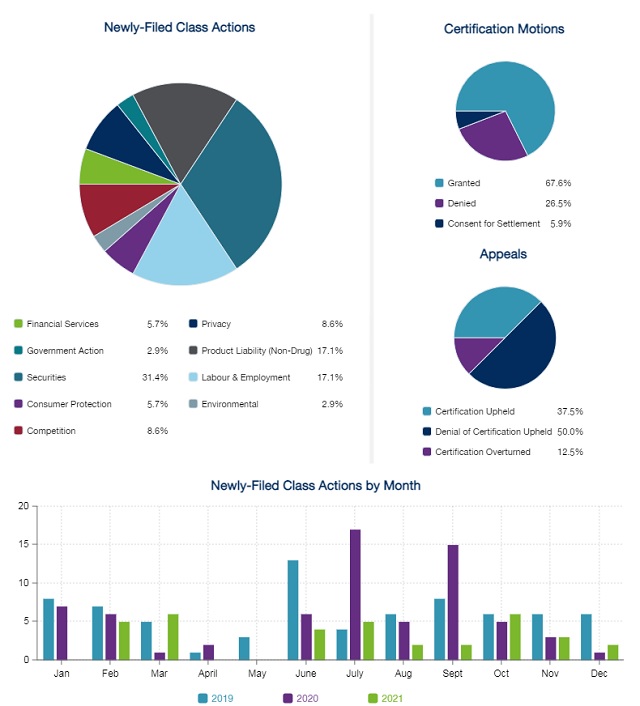- with Senior Company Executives, HR and Finance and Tax Executives
- in Canada
- with readers working within the Accounting & Consultancy, Banking & Credit and Insurance industries

TOP 3 Legal Developments of 2021
1 Courts Limit Availability of Intrusion Upon Seclusion: In recent years, we have seen a large increase in the number of privacy class actions in Ontario. The main cause of action alleged in most of these cases has been the tort of "intrusion upon seclusion". That tort was recognized by the Court of Appeal ten years ago in Jones v. Tsige. As defined by the Court of Appeal, the tort requires that the defendant invaded the plaintiff's privacy "intentionally" or "recklessly". Despite this requirement, in many recent class actions plaintiffs sued companies and organizations that were, themselves, victims of cyber attacks. This raised the question of whether the tort could apply to a defendant that did not itself invade the plaintiff's privacy but, rather, allegedly failed to prevent a third party from doing so. In Owsianik v. Equifax Canada Co., the majority of a panel on Ontario's Divisional Court has now held that a party that has failed to prevent a privacy breach may be sued for negligence, but not intrusion upon seclusion. That decision, which is under appeal, was applied to deny certification of a privacy class action in a more recent case. These decisions represent a significant development in the law. While those affected by a privacy breach can still sue information gatherers and custodians in negligence or for breach of contract, they generally will have to prove either pecuniary losses or a serious and prolonged disturbance in order to recover damages. This bring the law of Ontario more in line with the approach taken in Québec.
2 Ontario Courts Are Applying the Two-Step Test: In 2020, the Divisional Court held in Kuiper v. Cook, that judges hearing certification motions should apply a "two-step test" when deciding whether a case raises suitable "common issues". This means that plaintiffs must show that there is some basis in fact to support both the existence of the proposed issues, and that they are common to the whole class. In other words, there must be evidence that the proposed common issues are "live issues" whose determination will affect the rights of actual persons. Since Kuiper, certification judges in Ontario have been applying the "two-step test" to the common issues requirement, and the Divisional Court has also extended it to the question of whether there is an "identifiable class", in McGee v. Farazli. For more information, read our commentaries on Kuiper and McGee.
3 Inter-jurisdictional Cooperation: Class actions in Canada have always raised unique challenges. A "national" class action (covering class members across Canada) can be certified in any province. This means that there are often overlapping proceedings brought concurrently in more than one jurisdiction. In contrast to the United States, which has a statutory multi-district litigation process that allows claims to be transferred to a single court, Canada has no formal way to consolidate competing actions. In a number of recent decisions, however, Canadian Courts have demonstrated a willingness to meet this challenge through innovative and practical approaches, including releasing the first joint decisions across jurisdictions.
TOP 3 Trends of 2021
1 A slow year for class actions. In recent years, there has been a steady decline in the number of new class actions commenced in Ontario. 2021 saw a dramatic drop in new filings, with only slightly more than half as many claims as in 2020, and less than half the number commenced in 2019. In particular, while we continue to see quite a few securities class actions, other types of claims have dropped off significantly. We have also seen fewer settlement approval motions than in previous years.
2 Reinforcement of evidentiary requirements. While plaintiffs need only show "some basis in fact" to satisfy the criteria for certification (other than the existence of a cause of action, which requires no evidence), Ontario courts have been holding plaintiffs to that threshold. This has been evident from the application of the "two-step test" (see above) and in other recent jurisprudence stressing the need for evidence that meets the normal criteria for admissibility.
3 Appellate Courts ruling for defendants. Appellate courts in Ontario seem to be favouring defendants, at least when compared to certification judges. While plaintiffs won over two thirds of contested certification motions, defendants were successful in almost two thirds of the appeals brought from certification motions (with "success" for defendants meaning that the appellate court either overturned certification or upheld the denial of certification).
TOP 3 Things to Watch for
1
Forum Shopping: Ontario is arguably becoming a less plaintiff-friendly jurisdiction. Last year's amendments to Ontario's Class Proceedings Act, 1992, among other things, imported the requirement that common issues "predominate" over individual issues and encourage pre-certification motions. Read BLG's commentary on the legislative amendments or watch a presentation about them from BLG's latest Class Actions Seminar (relevant portion begins at 0:01:45). Moreover, the decisions highlighted above, emphasizing the "two step" test and the evidentiary requirements for a number of the certification criteria, may make it harder for plaintiffs to achieve certification. These developments, when combined with Ontario's "loser pays" costs regime and the fact that a national class can be certified in any province, could lead some plaintiffs' lawyers to look for greener pastures for class actions. The significant year-over-year decreases in new class actions in Ontario may be partly due to plaintiffs choosing to litigate in other provinces or in the Federal Court, rather than in Ontario. It will be interesting to see whether new filings in Ontario continue to decline over the balance of the year.
2
Privacy in the Court of Appeal: As noted above, the Divisional Court has held that the tort of intrusion upon seclusion does not apply to a person or entity that fails to protect a plaintiff's personal information from third-party wrong-doing. This is an important legal development with potentially wide-ranging effects on a number of pending class actions against companies that were the victims of cyber hacking. That decision is under appeal, so the Court of Appeal may soon render its first decision in a class action for intrusion upon seclusion.
3
Effect of Amendments within Ontario: The amendments to Ontario's Class Proceedings Act, 1992, which came into force on October 1st of last year, so far have received limited judicial consideration. The first decision to consider the amendments, however, held that the amendments reflect a strong legislative signal that motions by defendants that can narrow or dispose of a case should be presumptively heard before certification. This is welcome news for defendants facing fatally-flawed class actions and who want to avoid the delay and expense associated with defending certification. Courts have also applied a strict interpretation to the provisions that permit the dismissal for delay of dormant class actions. It remains to be seen whether the courts will take a similarly defendant-friendly approach to other amendments, including those that have arguable raised the bar for certification.
TOP 3 TAKE-AWAYS
1 Time to get tough? In recent years we have seen the Supreme Court of Canada place important restrictions on the ability of class members to recover damages when they have not suffered direct and foreseeable losses in in Atlantic Lottery Corp. Inc. v. Babstock and 1688782 Ontario Inc. v. Maple Leaf Foods Inc. ( Read BLG's commentary on the Atlantic Lottery decision and its implications or watch a presentation on the case from BLG's latest Class Actions Seminar – the relevant portion begins at 1:14:12 – or Read BLG's commentary on the Maple Leaf decision). The Ontario Legislature has made the test for certification more stringent, certification judges have reiterated the evidentiary threshold for certification and the Province's appellate courts have shown greater receptivity to arguments against certification. In addition, at least one decision has interpreted the amendments to the Class Proceedings Act as encouraging pre-certification motions in appropriate cases. All of these trends, taken together, suggest that defendants fighting against certification in Ontario may have a better chance of success than they have had in a number of years. It is more important than ever for defendants to retain experienced class actions counsel who have their finger on the pulse of the most recent trends and can advise them as to whether to oppose certification.
2 Expect claims in other jurisdictions. As a result of the changes in the law and emerging trends in Ontario described above, we may continue to see a decrease in class actions commenced in Ontario. In particular, plaintiffs increasingly are choosing instead to commence national class actions in other provinces (especially in British Columbia) and to bring competition claims in the Federal Court. Companies and organizations will need legal counsel able to represent them in all of Canada's key class actions jurisdictions (Ontario, British Columbia, Québec and in the Federal Court).
3 Keep watching the hotspots. In our 2020 Ontario Class Actions Year in Review, we identified a number of COVID-19 "hot spots". Companies and organizations should continue to monitor policies and procedures that relate to those areas: consumer protection, securities, employment, privacy, healthcare, insurance and products liability. They should consult legal counsel as soon as they identify issues or receive complaints relating to these areas, in order to prepare for potential class actions before claims are brought. To get a sense of where your risk lies, monitor and track complaints whether sent directly to you or expressed through social media.
The content of this article is intended to provide a general guide to the subject matter. Specialist advice should be sought about your specific circumstances.







